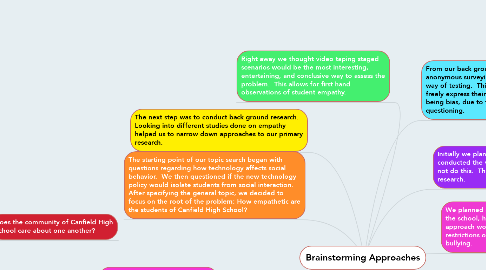Brainstorming Approaches
by Rachel Rafoth

1. The next step was to conduct back ground research. Looking into different studies done on empathy helped us to narrow down approaches to our primary research.
2. Does the community of Canfield High School care about one another?
3. The starting point of our topic search began with questions regarding how technology affects social behavior. We then questioned if the new technology policy would isolate students from social interaction. After specifying the general topic, we decided to focus on the root of the problem: How empathetic are the students of Canfield High School?
4. Right away we thought video taping staged scenarios would be the most interesting, entertaining, and conclusive way to assess the problem. This allows for first hand observations of student empathy.
5. Some students felt uncomfortable with the interview, therefore we had to go back and ask the students if they were okay with being part of the research. We overlooked this aspect in the beginning, but it adds safety to our research. Conducting the research with the concern of others makes for happy test subjects.
6. Next we thought interviewing teachers would add good insight to our research. We were faced with the struggle of teachers agreeing to being interviewed. We asked questions including: How much do the kids of Canfield High School care? How often do you see kids helping other kids out in the halls?
7. When putting everything together, we made five graphs that show different comparisons and a short video of our staged scenarios.
8. In conclusion, Canfield High School does care about one another.
9. We planned on connecting our research to bullying instances in the school, however it was too difficult to collect data. This approach would not have led to accurate results because of restrictions on proper testing. We could not stage a scenario of bullying.
10. From our back ground research we concluded that anonymous surveying would be the most feasible way of testing. This is because students could freely express their personal responses without being bias, due to the atmosphere of controlled questioning.
11. For our video testing, we chose two simple scenarios: dropping books and holding the door for someone. These situations were the easiest to control, film, and execute.
12. After video taping the students involved in the scenarios, we interviewed the students or students who helped or did not help the student in need. We asked several questions: Why did you help the student? Do you know the student you helped? Would you help anyone that dropped their books?
13. Initially we planned on surveying students before and after we conducted the video testing, but because of time we could not do this. This would have increased the validity of our research.


